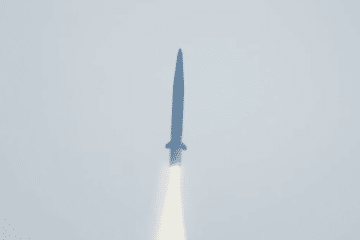The event was held on a reduced scale while complying with COVID-19 guidelines, and was held in the presence of about 40 people, including Chairman of the Joint Chiefs of Staff Won-cheol Won, and ROK Navy’s Chief of Naval Operations, Admiral Boo Suk-jong
First ship of the class, ROKS Daegu, was built by DSME. It was launched in June 2016 and commissioned with the ROK Navy on March 6, 2018. Second ship of the class, ROKS Gyeongnam was launched in June 2019 and commissioned in January this year. It was built by DSME as well. The third and fourth frigates of the class ROKS Seoul and ROKS Donghae were built by Hyundai Heavy Industries (HHI) and were launched in November 2019 and April 2020 respectively. The fifth vessel in the class, ROKS Daejeon (FFG-823 was launched in May 2021 by DSME.
A total of 8 frigates of this class, also known as the Incheon-class batch II or FFG-II , are set to be built by both DSME and Hyundai Heavy Industries, for the South Korean fleet.
Jeong Yeong-soon, head of the warship power division at the Naval Headquarters, said:
“The Pohang has improved detection and attack capabilities for surface and submarine targets, and based on its enhanced anti-submarine capabilities, it will play an active role as the main warship of the maritime fleet in the future.”
Bang Geuk-cheol, head of the naval division of the Defense Acquisition Program Administration, said:
“The Pohang is a state-of-the-art warship with significantly enhanced anti-submarine warfare capabilities.”
ROKS Pohang is set to be commissioned with the ROK Navy in early 2023. A program to build the third batch (FFX III) frigates which will displace over 3,000 tons and feature a phased array radar is also underway. HHI announced last year that it signed a contract for the detailed design and construction of the 3,500 ton FFX Batch III frigate.
About Daegu-class FFX Batch II frigate

The frigates are an improved version of the Incheon-class (FFX batch I). FFX Batch II frigates displace 2,800 tons (3,593 tons full load), are 122 meters long, 14 meters wide and 34 meters high. They can accommodate a maritime helicopter.
They are fitted with a 16-cell Korean vertical launching system (K-VLS) to deploy K-SAAM (Korean Surface to Air Anti Missile), Hong Sang Eo (Red Shark) anti-submarine missile, and Haeryong (SSM-701K Sea Dragon) tactical land attack cruise missiles. They are also fitted with torpedo launchers for anti-submarine warfare and eight SSM-700K Haeseong anti-ship missiles. All these missile systems are designed and produced by local company LIG Nex1. The gun systems consists in a Mk 45 mod. 4 naval gun system (main gun) and a Phalanx Block 1B CIWS.
Powered by four MTU 12V 4000 M53B diesel engine and one Rolls-Royce MT30 gas turbines in a Combined diesel-electric and gas (CODLAG) arrangement, the frigate features a hybrid propulsion system to reduce underwater radiated noise. The class is capable of reaching speeds of 30 knots, according to DAPA.
According to the ROK Navy, the new frigate features “advanced sonar and power systems to boost anti-submarine capabilities in coastal operations”. The SQR-250K TASS, low frequency passive sonar system is used for detecting, identifying and tracking enemy submarines. Its hybrid propulsion system reduces underwater radiation noise, which greatly enhances the anti-submarine ability of the vessel.






